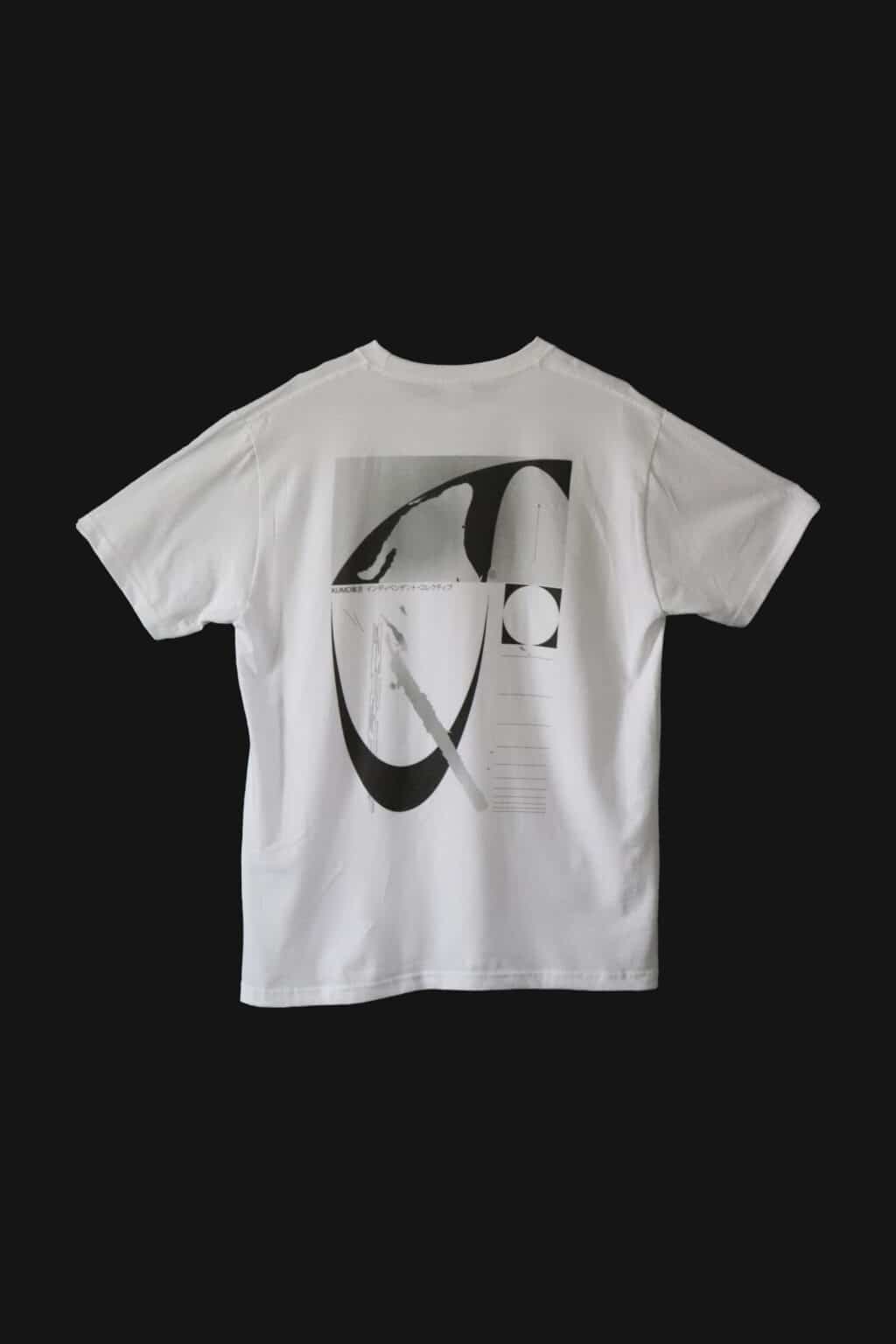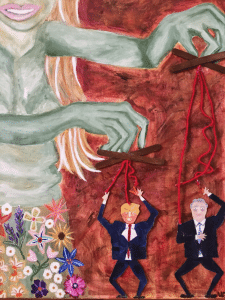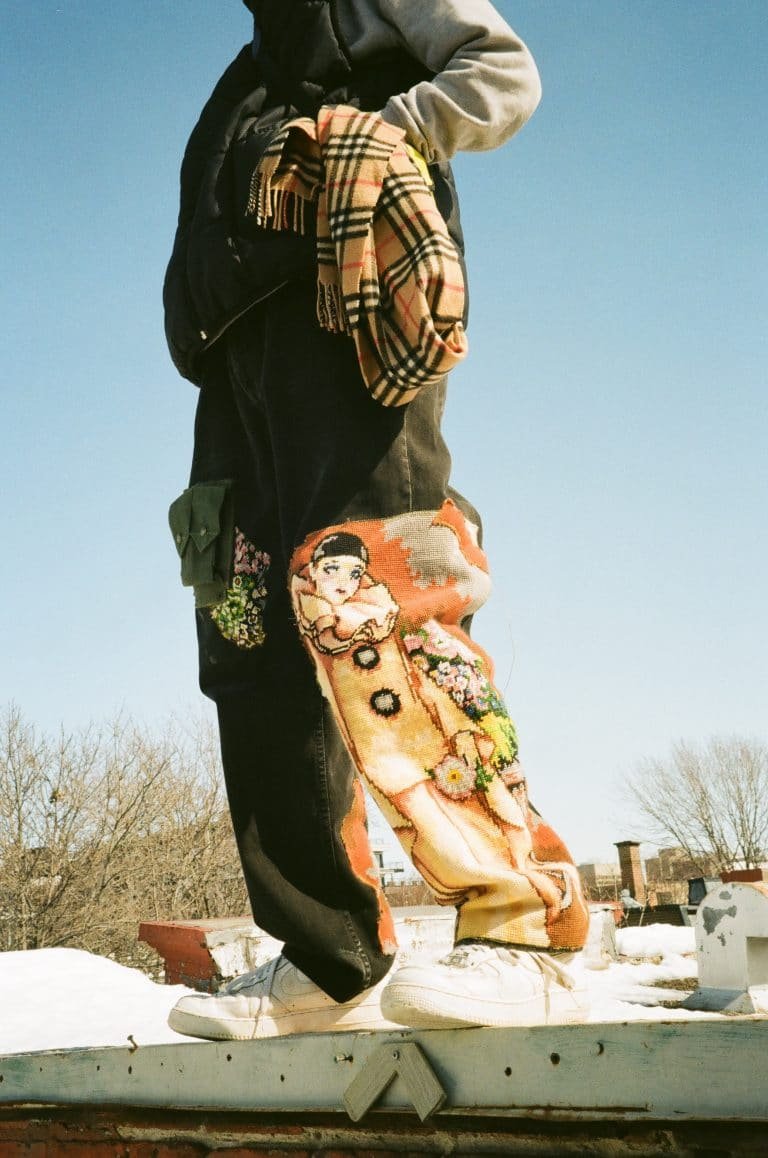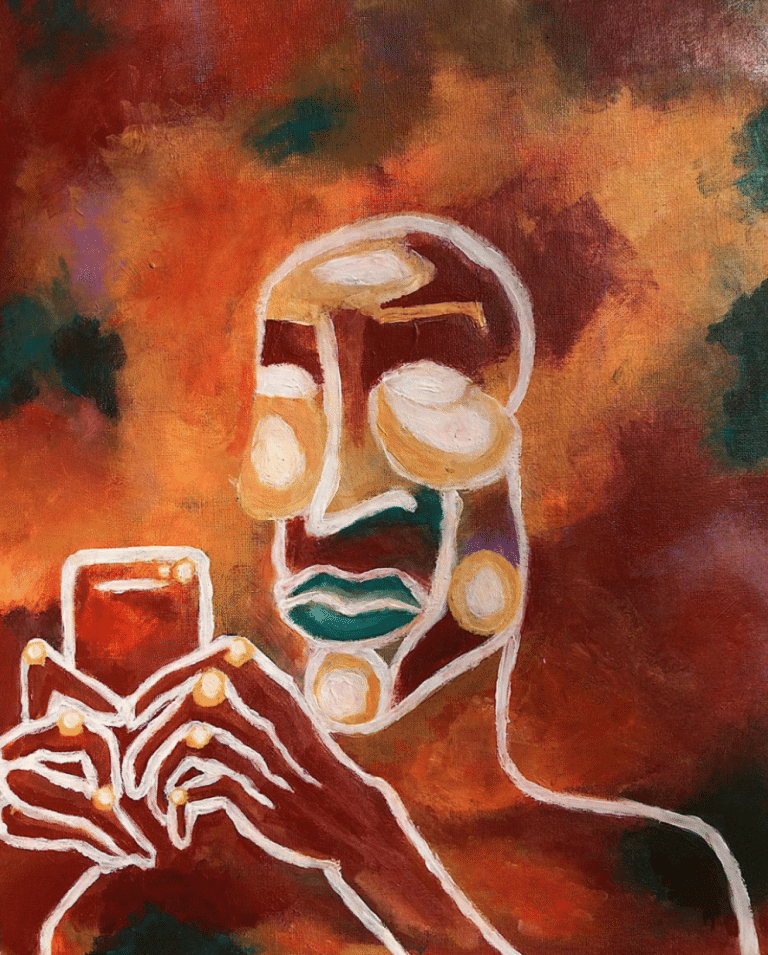Artistic Ascensions in Montreal
Text by Celia Saada
In order to get a sense of closure on our years in Montreal and our young, artistic community’s development, environment, and political dynamics, I have interviewed three young artists blossoming in Montreal. All three of them have brought their art, production, and creativity to new heights while they pursued their studies in Montreal.
Andrea is in her fourth year of studying anthropology and environment at McGill’s Arts faculty. She is a painter. Christophe Sam, or AVC, will soon graduate with a diploma in Politics and Communications from UDM. He is a singer and rapper. In the meantime, Elijah is now halfway through his second year at the McGill Business faculty, while designing, upcycling and re-styling jeans.
Three profiles, three academic fields, with different origins, and cultural backgrounds, expressed through three different artistic mediums. These three young artists are all at different stages in their artistic journeys and growth in Montreal. Besides their age, ranging between 20 or 21, Montreal, and art, what do these young artists, regardless of their fields, have in common when looking at their artistic expansion during their time in Montreal?
With so many young local artists blooming in Montreal around us, we wonder: Why are these artistic expansions triggered in Montreal? What dynamics are at play in Montreal’s artistic sphere? What are its impacts on the artist and his work? Do Andrea, AVC, and Elijah think of their art as personal, public, or both? Will Elijah, being at earlier stages of his journey in Montreal, share common artistic conceptions, perspectives, motives, successes, and responses as Andrea and AVC? Will his journey resemble theirs? Do Andrea and AVC even share opinions, hindsight, and perceptions on the Montreal artistic sphere?
The first artist, Andrea Kilajian, has started painting and sketching around the age of fifteen. Nevertheless, her emotional, creative, time and financial investments in her artistic productions have remarkably increased during her time in Montreal. Andrea’s work is deeply personal as it embodies and materializes her take on her emotions, political beliefs, background and culture. As her work gained more and more importance over her life, she began selling paintings and other derived products, while pursuing further artistic education (i.e. summer art program in Barcelona)..Andrea has exposed her work multiple times and has been a part of over seven exhibitions in less than two years in Montreal.


Our second artist is a musician, Christophe Sam or AVC (stage name). During the summer of 2017, AVC wrote his first ever track with two friends. In fall of the same year, AVC moved to Montreal in order to study and it is only there, surrounded by other artists, that he began to truly embrace and develop his musical sense. AVC kicked off his musical career with his debut single “Motionless” in January 2018, with the song managing to reach 3rd place on the Spotify France ViralTop 50 charts.
AVC kept on growing and working with numerous local artists, including Malchiodi, his roommate and producer.
His artistic encounters rocked the foundations of AVC’s music, which was then quickly showcased by his third single “Home”, a glimpse into his past experiences and a wink to the future ones as a growing artist striving to make it via various international platforms.
Despite having lost some opportunities to perform live (Covid-19), AVC has been building the KUMO international independent artistic collective aiming to bring together various artistic visions and fields by building a stronger network and ties amongst members. AVC is very much engaged in the artistic community and networks around him and as he sees it as an opportunity to expand artistic visions.
Finally, let me introduce, Elijah Deroche, whose artistic productions belong to the world of fashion, design and clothing. Elijah is only in his second year, and has been designing, confectioning and selling trousers (mainly, but amongst other pieces of clothing) since May of 2020. While the pandemic gave him additional time and incentives to further his sewing skills, it was only once he got back to Montreal this fall that his work elevated to other dimensions and proportions.
As he began exploring the possibilities when designing and upcycling jeans, his creativity flourished and expanded dramatically, thus giving birth to his brand, SOLEIL CONSTRUCTION.
Elijah takes a pair of jeans, whether it is yours, his own, or new, and restyles them by playing with patterns, fit, colors, pockets, etc. Elijah’s work combines the practical with the innovative and creative. His works are unlike any other you have ever seen, or you will ever see.
With constant new ideas and concepts, Elijah has used his sewing machine to extend the lifetime and boundaries of clothing, while allowing himself to dress some of Montreal’s youth and his friends.
While the artistic process sometimes requires collaboration with his customers given the possibilities for customizability, the artist’s vision never fades when it integrates your style, just like your style will not disappear under the artist’s vision.
Clothes fit the body and the mind, and when making pants for a specific individual, the artist does not fail to take into account your general sense of aesthetics.
Finally, Elijah, like many other students in Montreal, has been surrounded by art and producing long before the beginning of his newfound « passion for pants ». He has lived with artists, of all kinds, and often enjoys producing music.

Do you qualify yourself as an artist? If so, what made you first start calling yourself an artist?
ANDREA: I don’t qualify myself as an artist. I have been consistently producing art for the past two years and have received some artistic formation on the way, but I feel that the title “artist” englobes much more than just artistic production- it involves many external influential factors such as the art market. As a result, I feel the label “artist” is one that is given to you by others, in regards to how they understand your art’s role and contributions to society.
AVC: Yes I do. I think I really started perceiving myself as an artist the moment I was getting recognized by some of my peers, roughly about a year ago. When you’ve got people you respect and you consider as artists and they approve of your work, that’s when I felt like I’ve gained the confidence to see myself as an artist.
ELIJAH: I’m not sure I would classify myself as an artist. I make art and have a deep appreciation for it, both through observation and creation, but I don’t go around calling myself an artist.
How important are knowledge and culture in appreciating and producing your art?
ANDREA: I have some works that have a political and cultural message behind them, and in this context, having some basic background (on Armenia for instance) is needed when looking at some of my works. Nevertheless, since most of my work is not political, if the viewer does not hold prior knowledge and cultural understanding behind the meaning of one of my paintings, it does not mean that they cannot appreciate it.
Since I am not making art for others or particular public purposes, the audience’s interpretation will not taint my original goal when making the painting. I enjoy hearing people’s unique interpretation of my work – I love to see how they connect and relate to it. However, I do understand that on a bigger scale when artists make important political pieces, like with the Emmett Till painting for instance, because of Dana Schultz’s interpretation and appropriation of the original picture, it requires historical background and knowledge to properly interpret and judge the piece.
Overall, I don’t get frustrated or hurt by people not understanding my work. To me, my paintings are images that you want to understand and relate to on your own as well, which is part of the beauty of art.
ELIJAH: I upcycle old materials in innovative ways to make pants that I personally love and have never seen before. While I do think it helps my audience develop a deeper appreciation for the pieces if they understand the cultural context surrounding the problems of excessive consumerism and fast fashion, which I’m actively trying to combat, I don’t think it’s fair to say that the clothes I make have meaning solely for those people. Some people might gravitate towards my work simply because they look cool and like the designs. I haven’t bought new clothes for years, so when I began sewing last May, it just started because I wanted to repair an old pair of sweatpants and make them look better. I didn’t start sewing because I wanted to combat fast fashion, my work just happened to align really well with my moral and personal beliefs. That being said, I think anybody can draw value out of my pieces, and it might even promote them to start considering the ethical impacts of their consumption.

“Overall, I don’t get frustrated or hurt by people not understanding my work. To me, my paintings are images that you want to understand and relate to on your own as well, which is part of the beauty of art.”
Cutting Ties, Andrea Kilajian
How do you price your artistic production? Related to time-complexity? To the financial and/or physical investment put in it?
AVC: I can’t really put a price on it, to be honest. There are a lot of different investments that go into our work. Obviously getting the right tools to produce fully is key and it’s quite expensive. Then there’s also the mix/master for which the prices vary. Music is a lot of logistics, so investing at the right time and in the right places plays its part in your growth. Also how much time you can afford to invest in your art is complex because everyone has their own approach. I tend to work every day, but that’s just me. Time is money, I understand that expression way more now than before. The amount of hours you spend on a track is the difference between a good piece and a great one. You simply just have to grind to be able to do what you wanna do, there is no secret.
ANDREA: I price my artistic productions based on physical, time, financial investments, and most importantly, attachment (emotional, psychological…) which will be the make or break of whether I want to even sell the painting, or not. If I take two days to make a small painting with cheap acrylics, whereas if I were to buy a bigger canvas with quality acrylics and paintbrushes while investing a month of my time producing the painting, my psychological attachment to the painting increases as well. So I guess you could see a positive correlation between the time-complexity financial investments and my personal attachment to the painting. This will then help me decide how to price my painting.
“Producing something simply because the masses will like, it becomes a constraint on artistic freedom. While I don’t think it’s inherently bad to want recognition, I think artists have to be careful and make sure that what they’re producing is genuine.” ELIJAH DEROCHE
How big of a part plays recognition in your artistic process? Do you feel like recognition is necessary to your art? If so, what does it bring to your artwork?
AVC: Yes, but you also have to be able to rise above it. The fact that others can see themselves through your art is amazing, I swear, it’s an indescribable feeling. That makes you wanna go higher, connect with even more people, hear their stories and understand their perception of your own work. It mostly always ends up with me getting inspired by the similarities or differences that I have with certain people, so yes I think recognition is important and helpful. Sometimes it even leads to collaborations with other artists and that’s crucial for your development. Also, self-confidence grows in those moments and lets you explore new sounds, which is superb.
ELIJAH: No, recognition is defiantly not essential to the creative process. Recognition is extremely valued in our society, whether it’s Instagram followers, a number of sales, or just your friends telling you they like what you’re putting out, it encourages people to keep doing what they’re doing. Obviously, it is nice to be recognized and commended for your work, but I don’t think it’s a necessary aspect of the artistic process. I think when artists focus too much on recognition, it’s usually just for their ego rather than the creative process. Furthermore, producing something simply because the masses will like, it becomes a constraint on artistic freedom. While I don’t think it’s inherently bad to want recognition, I think artists have to be careful and make sure that what they’re producing is genuine. You don’t want to get famous producing something you don’t even like making.
Does your art need to be made public? Why is it important for you to publish, promote and share your artwork?
AVC: Art needs to be shared, even if there’s always a hard and excruciating process between your first creations and the moment you decide to release them. It’s more mental than anything but once you get that recognition from the people close to you whose opinion you value, it helps you get past the barrier that was blocking your first release date.
ANDREA: Yes! I truly believe that all art should be always shared, no matter the type or form of art. Because, why make art and not share it? The audience’s experience viewing any type of art form is such a subjective and intuitive experience because art touches one’s sensitivity and people may just encounter one of your works and it will simply make them happy, for no specific reason. You’re going to see one thing and you’re just going to instinctively like it, feel attracted to it, for whatever reason, and that in itself is a crazy experience.
ELIJAH: For sure. Unless you like dressing up in obscene outfits behind closed doors, clothing is one of the most public statements and representations of one’s self. Dressing well boosts people’s confidence and generally makes them feel better about themselves, and I love to bring that value to those around me. I can genuinely say I walk differently, step harder, and feel better when I’m out wearing my own pants.

“Art needs to be shared even though it means a hard and excruciating process between your first creations and the moment you decide to release them..”
AVC

Your artistic productions are one-of-a-kind and nonreplicable pieces. Walter Benjamin says that the uniqueness and authenticity of an artwork are gone with reproduction, arguing that it « extracts sameness even from what is unique ». Do you agree?
AVC: I do, in the sense that art is a cycle, we take from the past and try to create something new and fresh every time. But copying without innovating isn’t great, you’ve gotta be able to take it one step further or make it completely different (with the beat, your lyrics, your mixing, anything really). Finding the thing that makes you unique is a struggle but once you get to that point, it’s the craziest vibe because you start to get into the art you wanna be making.
ELIJAH: For sure. Every piece of mine is a one-of-one, and that definitely adds a lot of value in my opinion. That’s not to say that I don’t draw inspiration from others’ work though. I remember working at my desk looking outside, and I saw someone walk down the street with an awesome denim tote-bag, and I just dropped everything I was doing and got to work creating my own rendition of it. My final product looked a lot different from what I had seen, but it was entirely inspired by someone else’s work.
ANDREA: I have frustrations putting pictures of my paintings on Instagram because in doing so I’m posting an image of an image so it’s not the reality of the painting. Different things of the painting will come out which is a totally different experience than viewing the painting in real life. The texture of the paint itself is part of the beauty of the painting, and by removing that by transposing the painting to an Instagram post, a t-shirt or print, it is no longer the real thing.
Do you feel more empowered in society thanks to the publication and recognition of your art (as something that represents you, what it stands for, its political message, its re-appropriations…)?
ANDREA: Yes, I do feel more empowered in society thanks to the publication and recognition of my art. When you publicize your art and others recognize or validate it, it does not change or ameliorate my own perception of my work. I don’t prefer some paintings to others according to their popularity. But it is just a cool feeling when people associate me with my paintings because I’m proud of them and they are a part of me. Ultimately we all have a need for validation and recognition as human beings, and if this can happen through and thanks to my paintings, I am happy because it is a part of me that I am proud of.
ELIJAH: Definitely. While I’ve only recently started creating, and haven’t gained wide recognition for my work, it’s always nice to hear friends telling me they like what I’m making. The best feeling though is when I hear back from people that have pairs, I’ve made telling me all the compliments they get while out wearing them. It feels good that I’ve helped create a standout piece that they’ll love to wear, and likely keep for many years

Do you feel like the artistic environment around you, the subaltern counter-public of art in Montreal (collectives, featuring, trends, etc.), has been beneficial to you and to your art? Has it allowed your art to expand? Or on the contrary, is this expansion an instrument for private interests?
AVC: Yeah definitely! I’ve performed on stages thanks to collectives and that helped me a lot. It built my audience and credibility as an artist. I’ve worked and hoped to work again with a lot of the guys in those teams because I just rate them. Collaborations and working with teams and people from Montreal and around the world is what made me wanna create The Kumo Collective, a house of art for emerging artists. I’ll always cherish the memories I made over there and it made me who I am today. So I’m very grateful. Love to all my team and those who’ve made my journey this sick and creative, no days off.
ANDREA: I feel the artistic environment in Montreal has greatly motivated and inspired me. Thanks to the murals and artists at every corner in the Plateau, I feel a direct influence and engagement with Montreal art. Thanks to different collectives, such as Chasse et Pêche, I had the opportunity to meet independent artists with whom I was able to collaborate with. Through this relationship, we are able to support, uplift, and learn from each other, which is such an incredible experience. Presenting my art at local small galleries such as Usine 106u has allowed me to engage and explore other people’s works, and this dynamic of sharing and discussing ultimately leaves a trace in our artistic process. I believe that these types of collaborations, both on the small scale of just discussing each other’s works and the larger scale of working on the same project reflect the beauty of the essence of art- inclusivity.
However, I feel not all collectives or galleries strive for inclusivity, in my experience. There also exist groups in which their basis is exclusivity- they only present themselves or works they deem to be worthy or not of being displayed. This reflects superiority and bourgeoisie in art, and at the end of the day, so many of us make art to fight this sense of exclusivity we find in society.

Smile, Andrea Kilajian

